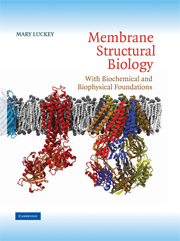Book contents
- Frontmatter
- Contents
- Preface
- 1 Introduction
- 2 The Diversity of Membrane Lipids
- 3 Tools for Studying Membrane Components: Detergents and Model Systems
- 4 Proteins in or at the Bilayer
- 5 Bundles and Barrels
- 6 Functions and Families
- 7 Protein Folding and Biogenesis
- 8 Diffraction and Simulation
- 9 Membrane Enzymes and Transducers
- 10 Transporters and Channels
- 11 Membrane Protein Assemblies
- 12 Themes and Future Directions
- Appendix I Abbreviations
- Appendix II Single-Letter Codes for Amino Acids
- Index
- References
3 - Tools for Studying Membrane Components: Detergents and Model Systems
- Frontmatter
- Contents
- Preface
- 1 Introduction
- 2 The Diversity of Membrane Lipids
- 3 Tools for Studying Membrane Components: Detergents and Model Systems
- 4 Proteins in or at the Bilayer
- 5 Bundles and Barrels
- 6 Functions and Families
- 7 Protein Folding and Biogenesis
- 8 Diffraction and Simulation
- 9 Membrane Enzymes and Transducers
- 10 Transporters and Channels
- 11 Membrane Protein Assemblies
- 12 Themes and Future Directions
- Appendix I Abbreviations
- Appendix II Single-Letter Codes for Amino Acids
- Index
- References
Summary
While progress in biochemistry, biophysics, and structural biology relies on studies of purified biological components, the purification of membrane components is complicated by their amphipathic nature. First, their removal from the membrane usually requires disruption of the lipid bilayer. Once removed, they tend to aggregate in aqueous buffers due to their low solubility in water. And finally, study of the functions of many membrane components requires their insertion back into a reconstituted membrane. The critical tools that allow in vitro characterization of membrane components are detergents and model membranes. Detergents are used to solubilize membrane components, removing them from the lipid bilayer and preventing their aggregation. This chapter begins with an overview of detergents, emphasizing their mechanisms of action in solubilizing membrane components.
The goal of reconstitution is to insert the purified membrane component into a good mimic of the biological membrane, usually a lipid bilayer. Because many aqueous lipid mixtures spontaneously assemble in lamellar phase (see Chapter 2), model bilayers tend to form spherical vesicles called liposomes. Liposomes are just one type of model system used for in vitro characterization of membrane components. Even for that one type, the nature of the lipid vesicles depends on how they are made and determines their suitability for different experimental techniques. By necessity, these models are simpler than biological membranes, which contain hundreds of lipid species; depending on the objective, a single lipid species can often suffice.
- Type
- Chapter
- Information
- Membrane Structural BiologyWith Biochemical and Biophysical Foundations, pp. 42 - 67Publisher: Cambridge University PressPrint publication year: 2008



